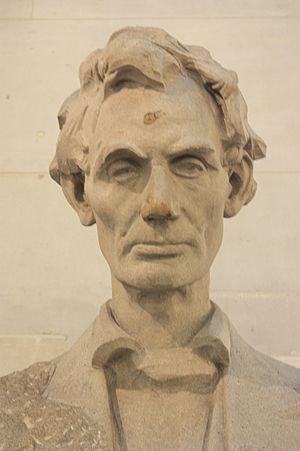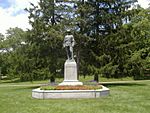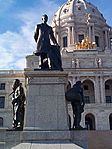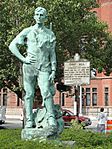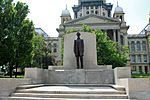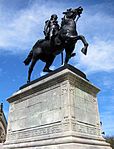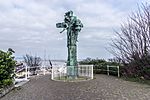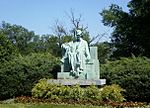Andrew O'Connor (sculptor) facts for kids
Andrew O'Connor (born June 7, 1874 – died June 9, 1941) was a talented sculptor from America and Ireland. His amazing artworks can be found in museums across America, Ireland, Britain, and France.
Contents
About Andrew O'Connor
Andrew O'Connor was born in Worcester, Massachusetts, USA. He later passed away in Dublin, Ireland.
Early Training and Success
When he was younger, O'Connor spent time in London. He worked in the studio of a famous painter named John Singer Sargent. Later, he worked with well-known architects, McKim, Mead and White, in America. He also learned from another sculptor, Daniel Chester French.
In the early 1900s, O'Connor moved to Paris, France. He showed his sculptures every year at a big art show called the Paris Salon. He became very successful there.
In 1906, he made history! He was the first sculptor from another country to win a special medal. This was for his statue of General Henry Ware Lawton. You can still see this statue in Garfield Park in Indianapolis today.
Later, in 1928, he won an even bigger award, the Gold Medal. This was for his beautiful marble sculpture called Tristan and Iseult. This artwork is now at the Brooklyn Museum in New York.
Andrew O'Connor's sculptures were even part of the 1928 Summer Olympics. Back then, the Olympics had art competitions, and his work was featured in the sculpture event.
Where to See His Art
Many of O'Connor's plaster models are kept in the Hugh Lane Municipal Gallery in Dublin, Ireland. You can also find his finished sculptures in famous museums. These include Tate Britain in London and the Metropolitan Museum of Art in New York. His art is also at the Walters Art Museum in Baltimore and the Musée d'Art Moderne in Paris.
A Commissioned Statue
In 1909, O'Connor was asked to create a statue of Commodore John Barry. Barry was an important naval officer during the American Revolutionary War. O'Connor created a design, but some groups did not like it. He then made a second design, but it was also not chosen. Another sculptor, John J. Boyle, ended up getting the job.
Famous Sculptures by O'Connor
Here are some of Andrew O'Connor's well-known works:
- Vanderbilt Memorial Doors, St Bartholomew's Church, New York City, 1901–03. These are grand doors for a church.
- General Henry Ware Lawton, Garfield Park, Indianapolis, Indiana, 1906. This is the statue that won him a medal in Paris.
- Statue of Lew Wallace, National Statuary Hall Collection, U.S. Capitol, Washington, D.C., 1910. A statue of a famous general and author.
- Governor John Albert Johnson, Minnesota State Capitol, St. Paul, 1912. A sculpture of a state governor.
- 1898 Soldier, Spanish–American War Memorial, Wheaton Square, Worcester, Massachusetts, 1917. This statue honors soldiers from the Spanish-American War.
- Abraham Lincoln, Illinois State Capitol, Springfield, 1918. A sculpture of the famous American president.
- The Victims, Merrion Square, Dublin, Ireland, c. 1923, (dedicated 1947). This artwork shows a kneeling wife and a standing mother mourning a soldier. It was first planned for a war memorial in Washington, D.C.
- A copy of Kneeling Wife (c. 1923) is at the Tate Britain museum.
- Lafayette Monument, Mount Vernon Place, Baltimore, Maryland, 1924. A large statue of a French hero who helped America.
- Christ the King, Dún Laoghaire, Ireland, 1926. A religious sculpture.
- Tristan and Iseult, Brooklyn Museum, Brooklyn, New York City, 1928. This is the marble group that won him the Gold Medal.
- Bust of Abraham Lincoln, Royal Exchange, London, United Kingdom, 1930. A sculpture showing only the head and shoulders of Lincoln.
- Seated Abraham Lincoln, Fort Lincoln Cemetery, Brentwood, Maryland, 1931 (dedicated 1947). This statue shows Lincoln sitting down. It was originally planned for Rhode Island but the project stopped during the Great Depression.
-
Gen. Lew Wallace (1910), U.S. Capitol, Washington, D.C.


